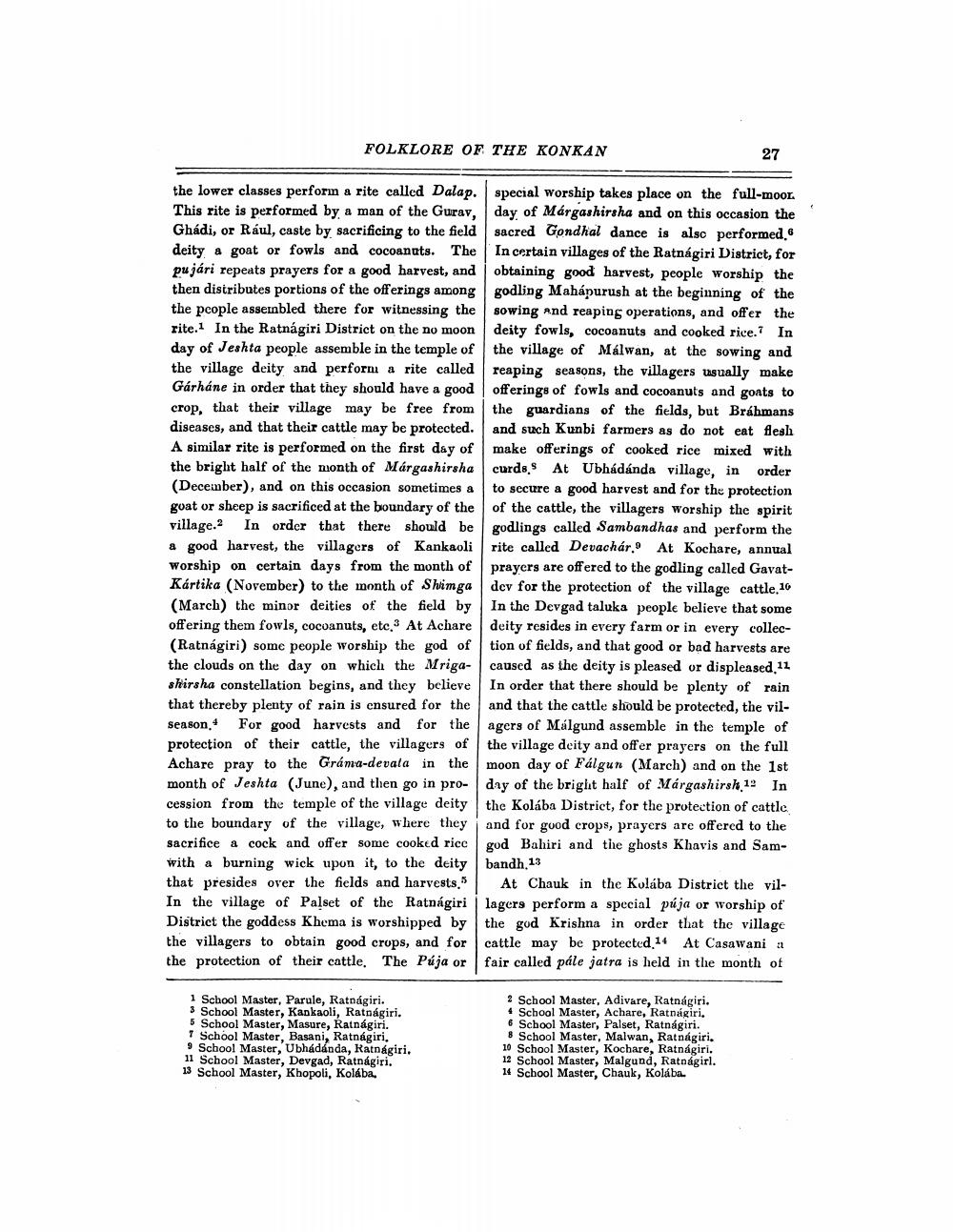________________
FOLKLORE OF THE KONKAN
27
the lower classes perform a rite called Dalap. special worship takes place on the full-moon
This rite is performed by a man of the Gurav, day of Márgashirsha and on this occasion the Ghádi, or Rául, caste by sacrificing to the field sacred Gondhal dance is also performed. deity a goat or fowls and cocoanuts. The In certain villages of the Ratnagiri District, for pujári repeats prayers for a good harvest, and obtaining good harvest, people worship the then distributes portions of the offerings among godling Mahápurush at the beginning of the the people assembled there for witnessing the sowing and reaping operations, and offer the rite. In the Ratnagiri District on the no moon deity fowls, cocoanuts and cooked rice.7 In day of Jeshta people assemble in the temple of the village of Málwan, at the sowing and the village deity and perform a rite called reaping seasons, the villagers usually make Gárháne in order that they should have a good offerings of fowls and cocoanuts and goats to crop, that their village may be free from the guardians of the fields, but Brahmans diseases, and that their cattle may be protected and such Kunbi farmers as do not eat flesh A similar rite is performed on the first day of make offerings of cooked rice mixed with the bright half of the month of Márgashirsha curds. At Ubhádánda village, in order (December), and on this occasion sometimes a to secure a good harvest and for the protection goat or sheep is sacrificed at the boundary of the of the cattle, the villagers worship the spirit village.2 In order that there should be godlings called Sambandhas and perform the a good harvest, the villagers of Kankaoli rite called Devachár. At Kochare, annual Worship on certain days from the month of prayers are offered to the godling called GavatKártika (November) to the month of Shimga dev for the protection of the village cattle 10 (March) the minor deities of the field by In the Devgad taluka people believe that some offering them fowls, cocoanuts, etc.3 At Achare deity resides in every farm or in every collec(Ratnagiri) some people worship the god of tion of fields, and that good or bad harvests are the clouds on the day on which the Mriga- caused as the deity is pleased or displeased 11 shirsha constellation begins, and they believe In order that there should be plenty of rain that thereby plenty of rain is ensured for the and that the cattle should be protected, the vilseason. For good harvests and for the agers of Málgund assemble in the temple of protection of their cattle, the villagers of the village deity and offer prayers on the full Achare pray to the Gráma-devata in the moon day of Fálgun (March) and on the 1st month of Jeshta (June), and then go in pro- day of the bright half of Márgashirsh 12 In cession from the temple of the village deity the Kolába District, for the protection of cattle to the boundary of the village, where they , and for good crops, prayers are offered to the sacrifice a cock and offer some cooked rice god Bahiri and the ghosts Khavis and Samwith a burning wick upon it, to the deity bandh 13 that presides over the fields and harvests." At Chauk in the Kolába District the vilIn the village of Palset of the Ratnagiri lagers perform a special púja or worship of District the goddess Khema is worshipped by the god Krishna in order that the village the villagers to obtain good crops, and for cattle may be protected 14 At Casawani a the protection of their cattle. The Púja or fair called pále jatra is held in the month of
1 School Master, Parale, Ratnagiri. 3 School Master, Kankaoli, Ratnagiri. 5 School Master, Masure, Ratnagiri. * School Master, Basani, Ratnagiri. 9 School Master, Ubhádánda, Ratnagiri, 11 School Master, Devgad, Ratnagiri. 13 School Master, Khopoli, Kolába.
2 School Master, Adivare, Ratnagiri. 4 School Master, Achare, Ratnagiri. 6 School Master, Palset, Ratnagiri. 8 School Master, Malwan, Ratnagiri. 10 School Master, Kochare, Ratnagiri. 12 School Master, Malgund, Ratnagirl. 14 School Master, Chauk, Kolába.




